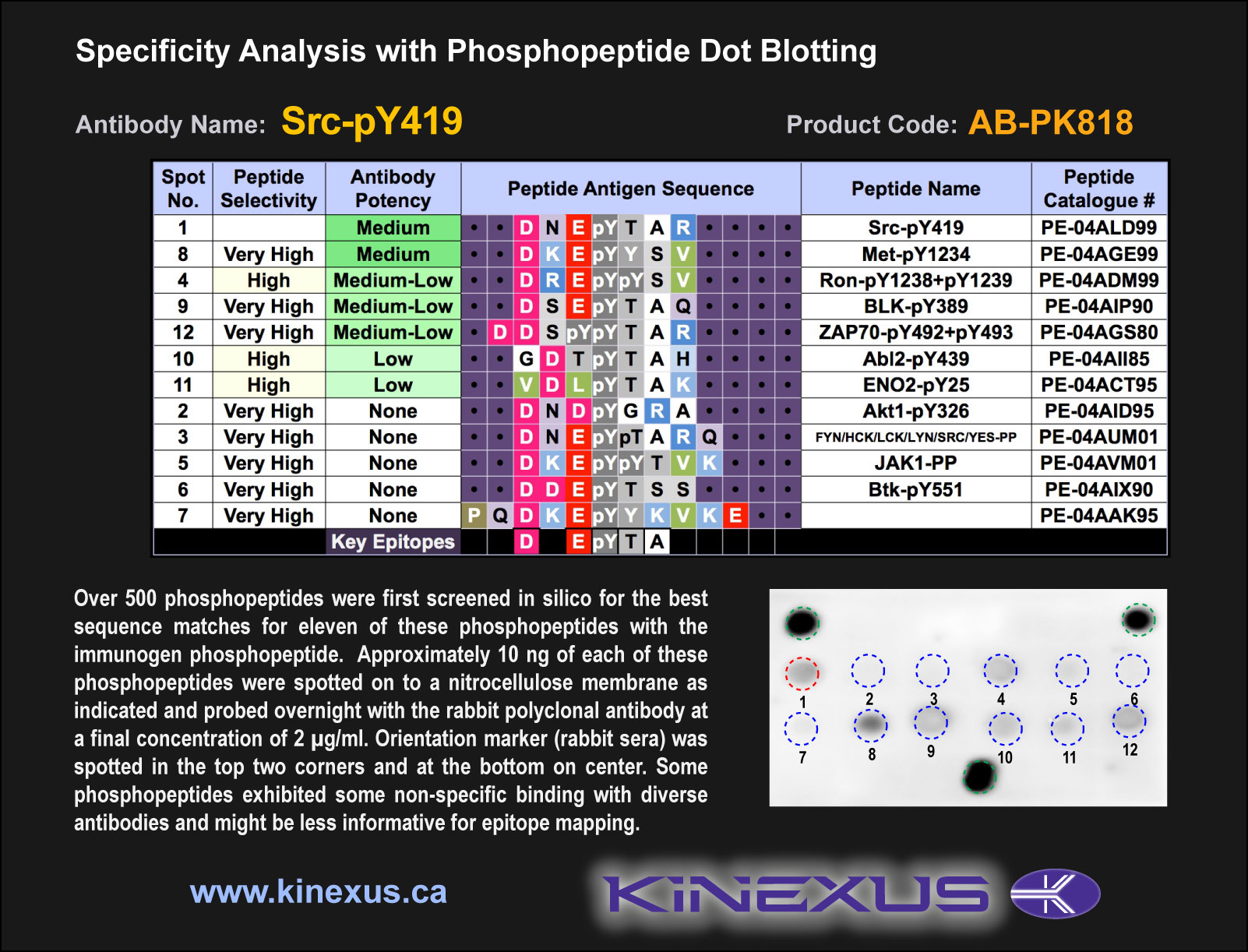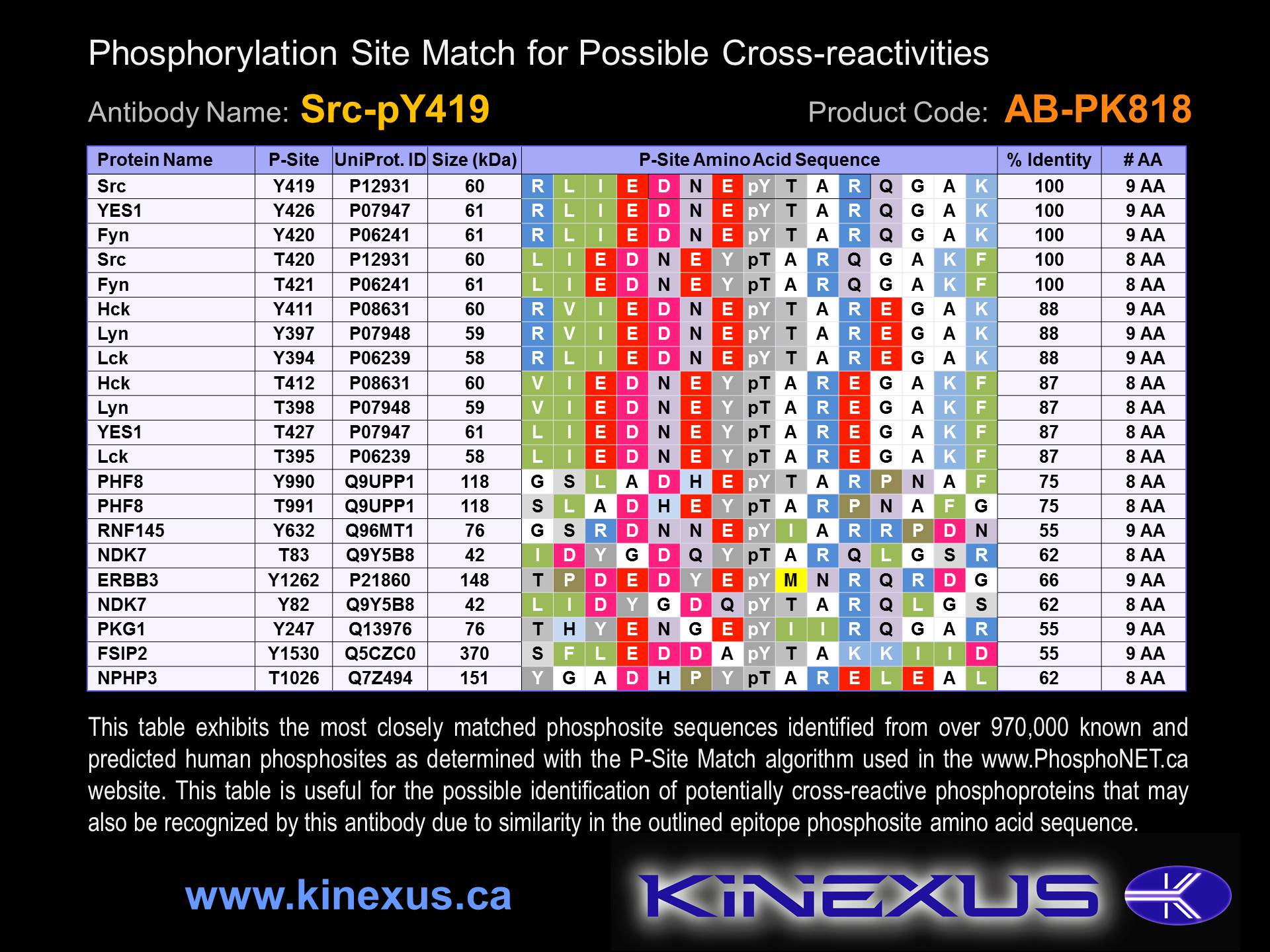Product Name: Src-pY419
Product Number: AB-PK818
| Size: | 25 µg | Price: | 89.00 | |
| $US |
Target Full Name: Src oncogene-encoded protein-tyrosine kinase
Target Alias: ASV; c-Src; p60-SRC; p60-Src; SRC1; ASV; CCDS13294.1; ENSG00000197122
Product Type Specific: Protein kinase phosphosite-specific antibody
Antibody Code: PK818
Antibody Target Type: Phosphosite-specific
Antibody Phosphosite: Y419
Protein UniProt: P12931
Protein SigNET: P12931
Antibody Type: Polyclonal
Antibody Host Species: Rabbit
Antibody Immunogen Source: Human Src sequence peptide Cat. No.: PE-04ALD99
Target Alias: ASV; c-Src; p60-SRC; p60-Src; SRC1; ASV; CCDS13294.1; ENSG00000197122
Product Type Specific: Protein kinase phosphosite-specific antibody
Antibody Code: PK818
Antibody Target Type: Phosphosite-specific
Antibody Phosphosite: Y419
Protein UniProt: P12931
Protein SigNET: P12931
Antibody Type: Polyclonal
Antibody Host Species: Rabbit
Antibody Immunogen Source: Human Src sequence peptide Cat. No.: PE-04ALD99
Antibody Immunogen Sequence: DNE(pY)TAR(bA)C
Antibody Immunogen Description: Corresponds to amino acid residues D416 to R422; In the protein kinase catalytic domain activation T loop region between subdomains VII and VIII.
Antibody Immunogen Description: Corresponds to amino acid residues D416 to R422; In the protein kinase catalytic domain activation T loop region between subdomains VII and VIII.
Production Method: The immunizing peptide was produced by solid phase synthesis on a multipep peptide synthesizer and purified by reverse-phase hplc chromatography. Purity was assessed by analytical hplc and the amino acid sequence confirmed by mass spectrometry analysis. This peptide was coupled to KLH prior to immunization into rabbits. New Zealand White rabbits were subcutaneously injected with KLH-coupled immunizing peptide every 4 weeks for 4 months. The sera from these animals was applied onto an agarose column to which the immunogen peptide was thio-linked. Antibody was eluted from the column with 0.1 M glycine, pH 2.5. Subsequently, the antibody solution was neutralized to pH 7.0 with saturated Tris.This antibody was also subject to negative purification over phosphotyrosine-agarose.
Antibody Modification: Unconjugated. Contact KInexus if you are interest in having the antibody biotinylated or coupled with fluorescent dyes.
Antibody Modification: Unconjugated. Contact KInexus if you are interest in having the antibody biotinylated or coupled with fluorescent dyes.
Antibody Concentration: 0.4 mg/ml
Storage Buffer: Phosphate buffered saline pH 7.4, 0.05% Thimerasol
Storage Conditions: For long term storage, keep frozen at -40°C or lower. Stock solution can be kept at +4°C for more than 3 months. Avoid repeated freeze-thaw cycles.
Product Use: Western blotting | Antibody microarray
Antibody Dilution Recommended: 2 µg/ml for immunoblotting
Antibody Potency: Medium-strong immunoreactivity of a target-sized protein by Western blotting in A431 cells and weakly in insulin-treated HeLa cells. Strong immunoreactivity with immunogen peptide on dot blots.
Antibody Species Reactivity: Human
Storage Buffer: Phosphate buffered saline pH 7.4, 0.05% Thimerasol
Storage Conditions: For long term storage, keep frozen at -40°C or lower. Stock solution can be kept at +4°C for more than 3 months. Avoid repeated freeze-thaw cycles.
Product Use: Western blotting | Antibody microarray
Antibody Dilution Recommended: 2 µg/ml for immunoblotting
Antibody Potency: Medium-strong immunoreactivity of a target-sized protein by Western blotting in A431 cells and weakly in insulin-treated HeLa cells. Strong immunoreactivity with immunogen peptide on dot blots.
Antibody Species Reactivity: Human
Antibody Positive Control: The observed molecular mass of the processed target protein on SDS-PAGE gels is reported to be around 57-65 kDa.
Antibody Specificity: High
Antibody Cross Reactivity: No significant cross-reactive proteins detected in A431 and HeLa cells, except for a medium-strong 80 kDa protein in both cell lnes as well as ~47 kDa protein in HeLa cells.
Related Product 1: Src-pY419 blocking peptide
Related Product 2: SrcSubtide - Src protein kinase substrate peptide
Related Product 3: CDK1 (6-20) KinSub - Cyclin-dependent kinase 1 (CDC2) (K6-K20, human) peptide; Src protein kinase substrate peptide
Antibody Specificity: High
Antibody Cross Reactivity: No significant cross-reactive proteins detected in A431 and HeLa cells, except for a medium-strong 80 kDa protein in both cell lnes as well as ~47 kDa protein in HeLa cells.
Related Product 1: Src-pY419 blocking peptide
Related Product 2: SrcSubtide - Src protein kinase substrate peptide
Related Product 3: CDK1 (6-20) KinSub - Cyclin-dependent kinase 1 (CDC2) (K6-K20, human) peptide; Src protein kinase substrate peptide
Scientific Background: Src is a protein-tyrosine kinase of the TK group and Src family. It is a non-receptor protein-tyrosine kinase that is widely distributed from low to moderate levels in most human tissues with highest expression in pancreas and stomach. Src was originally identified as a transforming protein of the Rous sarcoma virus (RSV) that had enzymatic ability to phosphorylate tyrosine in protein substrates. Src is activated by phosphorylation at S12, S75, Y419 and T420. S12 phosphorylation promotes interaction with PPP2R2C and Y410 phosphorylation induces interaction with Cbl-c. Phosphorylation at S17 may reduce phosphorylation at S12. Phosphorylation of S97 and Y530 inhibits Src phosphotransferase activity. Src is overexpressed and activated in a large number of human malignancies and has been linked to the development of cancer and progression to distant metastases. In addition to increasing cell proliferation, a key role of Src in cancer seems to be the ability to promote invasion and motility, functions that might contribute to tumour progression. Src has also been linked with the development of colon cancer. Insertional mutagenesis studies in mice also support a role for this protein kinase in mouse cancer oncogenesis. Although mutations that increase the catalytic activity of Src are well known, such as loss of the inhibitory tyrosine phosphorylation site at the C-terminus of the kinase, it is not subject to higher rates of mutations in human tumours than most proteins.
Figure 1. Epitope mapping of Src-pY419 antibody with similar phosphopeptides on dot blots.
Figure 2. Identification of phosphosites related to Src-pY419.
© Kinexus Bioinformatics Corporation 2017



